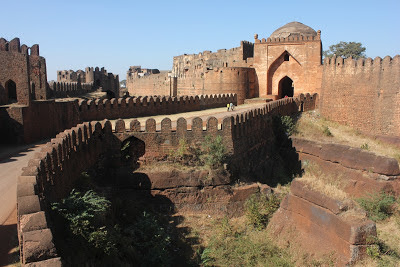 |
| Bidar fort - wide moat.karnatakatravel.blogspot.com |
 |
| Bidar fort, /karnatakatravel.blogspot.com |
 |
| Solah Kambha Mosque in Bidar Fort thehindu.com |
Among the old forts of India, Bidar Fort of Karnataka is a celebrated one and the town of Bidar became the seat of power of Sultan Alla-Ud Din Bahman of the Bahmanid Dynasty who, for many reasons, shifted his base in 1427 from Gulburga to this new one. As the region was prone to raids and invasions from other Islamic rulers, he had a strong fort built along with several structures with its confines . It is said that there are as many as 30 Islamic monuments inside the Bidar fort. This fort also is well known for old water structures like the Karez underground aqua ducts, terracotta pipes lines that supply water in heritage structures and the step wells in the nearby farms. Bidar is a nice tourist destination that will never disappoint you if you look for new adventures.
Standing on a natural plateau where laterite stones are available in plenty, with the river Manjira (a\tributary of Godavari) on the north, Bidar is part of the Godavari basin in North Karnataka. The Bidar district is geologically a part of the Deccan plateau (elevation is 2200 feet) made of mainly volcanic rocks called basalt underlain by gneissic rocks forming the eastern boundary. Bidar is just 116 km (72 mi) northeast of Gulbarga and 130 km (81 mi) on NH 9 from Hyderabad.
Bidar fort built by Ahmad Shah Wali Bahman had double lines of defensive fortifications for extra protection which is not present now; the old fort forms the western extension of the present fort. It was in the year 1321-22 AD Prince Ulugh Khan of the Tughlaq dynasty (later was known as Sultan Muhammad bin Tughluq) of Delhi Sultanate, captured Bidar. When Bahmini sultanate was established in 1347, Bidar was occupied by Sultan Ala-ud-Din Bahman Shah. Bidar was made the capital city of Bahmani Kingdom during the reign of Ahmad Shah I 1422-1486. Besides rebuilding the old Fort, Ahmed Shah I also had madrasas, mosques, palaces and gardens built there by 1432 CE. Bidar had a chequered history. The fort was captured by the Bijapur Sultanate in 1619–20, later came under the control of Mogul viceroy Aurangzeb in 1657. In 1686, it became the part of the Mogul Empire. In 1724, Bidar changed hands and this time it became a part of the Asaf Jahi Kingdom of the Nizams of Hyderabad. Asif Jah (first Nizam)'s third son Nawab Mir Sa'id Muhammad Khan (the first Nizam of the dynasty), ruled from Bidar fort from 1751 till 1762, when his own brother Mir Nizam Ali Khan, also known as Asaf Jah II, imprisoned him and later killed him in the fort on 16 September 1763.
Bidar fort is built mostly of laterite stones (laterite stones are equally strong as small grains, pebbles, etc are well compacted and bound together by the leaching of iron oxide from the ground. (Laterite stones are widely used in the foundation work of many buildings in Tamil nadu, The Maratha buildings in Thanjavur town and elsewhere are known to have foundation made of big blocks of laterite stones). The fort is 0.75 mi (1.21 km) long by 0.5 mi (0.80 km) in breadth (?) The fort walls measure 2.5 km (1.6 mi) on the outside. The fort is surrounded by a moat whose width varies from 32 feet to 42 feet; the depth is 30 feet.
The fort can be accessed by 7 gates strategically located from east to west. They are: Gate 1 - The Mandu Darwaza, the main gate, Gate 2 - The Kalmadgi Darwaza, Gate 5 - The Delhi Darwaza,
 |
| Bidar fort, Cannon in the bastion karnatakatravel.blogspot.com |
Gate 6 - The Kalyani Darwaza, Gate 7 - The Carnatic Darwaz,, Gates 3 and 4 are without a name.There are 37 bastions on the wall with canons made of bars of metals welded together and held firmly together with metal hooks mounted on the bastions.
Within the fort there are many buildings that show the influence of Persian architectural style. The include mosques, arches, gardens and the palaces built within and also outside the fort in Bidar.
 |
| Old Madrasa, Bidar findmessages.com |
Innovative systems of water management are seen in and around the fort and the town of Bidar. The salient feature is the unique water management system called Karez system, which is of Persian origin. The rocky soil is not suitable for water percolation downward. Hence this system was successfully employed here. It consists of a network of underground canals punctuated by vertical shafts to the surface at certain points. This system uses the ground water sources and takes the water supply to the settlement areas where the canals end in the pond or a huge water tank. The water is used for drinking , washing, ablution, agriculture, etc. The karez system was built with a view to supplying water to civilian settlements and the garrison inside the Bidar fort. This fort once had 21 vertical shafts, and extends for about 2 kilometres (1.2 mi). Only 17 are visible rest were closed by the real estate builders. In the past the Bidar fort could handle long sieges by enemies backed by sufficient water supply.















